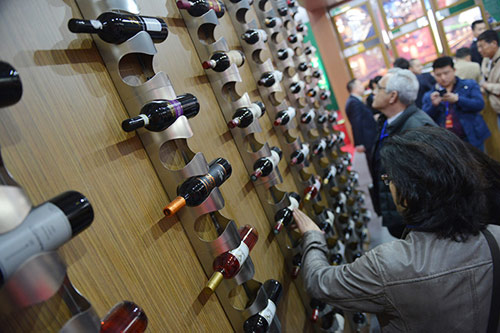
|
Chinese consumers' insatiable appetite for luxury goods and services appears unstoppable, with just 2 percent of the Chinese population responsible for one-third of the world's luxury items. As China's economic miracle continues and spreads across second- and third-tier cities, the market opportunities for all sorts of luxury goods and services are unfathomable. Luxury consumption in China now extends way beyond well-known car, clothing and jewelry brands. For example, the luxury jet market in China is the fastest-growing in the world, even outstripping that of the United States, with a market share of 25 percent. This trend appears set to continue, with 20 to 30 percent growth expected in China, compared with only 2 to 3 percent in the US. But more important, China's luxury jet market growth represents a major development in the private consumption of luxury items. China's high-quality red wine market also provides tangible evidence of the growth in private consumption of luxury goods. In 2013, China became the largest market for red wine in the world, even overtaking the French, with 1.86 billion bottles quaffed in China last year. Over the past five years, China's red wine consumption has grown 136 percent. But far more attention is still paid to the visible signs of Chinese consumers' luxury shopping. Public consumption of such expensive, sumptuous global luxury brands such as Prada and Armani is easily explained by the desire to "gain face" and publicly display social climbing through material possessions. Consequently, celebrity endorsement features heavily in the marketing of such luxury items Private consumption of luxury items is, however, less well understood. According to my ongoing consumer research in this area, it is "self-reward" that lies behind consumer motivation in this area. Chinese consumers who have experienced rapid financial and economic gains appear particularly prone to the need to reward themselves for their success. But this has little to do with "gaining face" and impressing others and much more to do with the need for personal contentment. As a result, the marketing of privately consumed luxury items, from jets to red wine, needs to adapt from the strategies and associations often employed where public consumption is concerned. Private consumption of luxury items is often a far more rational, planned and, therefore, deliberate process. In consequence, it is imperative that tangible product features and attributes are central to any marketing campaign and that exciting emotional associations do not dominate. The spectacular growth of high-quality red wine consumption by the Chinese probably has a lot to do with perceived health benefits, for example, in combination with typical emotional associations such as prestige and sophistication. Luxury jets are also probably acquired for their immediate, rational rewards such as convenience and speed. Private consumption of luxury items in China is also likely to represent a more calm and reflective experience, in comparison with the excitement and frivolity often key to public consumption. As a result, celebrity endorsement and profligate use of bright, ostentatious colors should play little part in any private luxury building of brands in China. Finally, the growth in private luxury consumption in China is set to continue in part due to the maturity of the Chinese consumer and advancement of Chinese consumer culture generally. (The author is a visiting professor at the University of International Business and Economics in Beijing and a senior lecturer on marketing at Southampton Solent University's School of Business. The views do not necessarily reflect those of China Daily.) MIKE BASTIN |
中国消费者对奢侈品和服务有着狂热的购买欲。仅2%的中国人口就包揽了全世界三分之一的奢侈品。 由于中国经济的奇迹不断,二三线城市发展迅速,各种奢侈品和服务的市场空间巨大。 中国的奢侈品消费已经不单单局限于名车、名牌服饰及珠宝。比如,中国的豪华专机市场在全球中发展最为迅猛,甚至远超美国,占据25%的市场份额。这种趋势似乎不会消停,中国这块消费市场的增长幅度预计高达20%至30%,相比之下,美国仅为2%至3%。 更重要的是,中国豪华专机市场份额的攀升代表了全国个人奢侈品消费的重要发展。 中国高档红酒市场同样也是个人奢侈品消费增长的切实证据。 2013年,中国成为世界上最大的红酒市场,去年甚至以18.6亿瓶的疯狂消费额赶超法国。过去五年里,中国的红酒消费已经增长了136%。 然而,人们更多关注的还是中国消费者购买奢侈品的显著迹象。 公众消费像普拉达、阿玛尼此类昂贵、奢华的全球奢侈品牌,原因很简单,就是为了“赚足面子”,并通过物质财富互相攀比。因此,名人代言在奢侈品市场中屡见不鲜。 然而,个人奢侈品消费就比较让人费解。据笔者对这一领域消费者的持续调查显示,“自我奖赏”是这一消费的潜在动机。 尤其是快速发家致富的中国消费者更倾向于以此嘉赏自己。但这与“赚足面子”和折服他人没有多大关系,反而更多是出于自我满足的需求。 因此,从飞机到红酒,个人奢侈品消费市场需要采纳借鉴公共消费的常用策略和关联性。 个人奢侈品消费行为通常更具合理性和计划性,因此,这是深思熟虑的过程。 为此,任何营销活动都务必以有形商品的特征和属性为中心,而非刺激性的情感联想。 例如,中国高档红酒消费的快速增长可能很大程度上与人们认知中的养生价值有关,还跟一些诸如声望和素养之类的典型情感联想有关。 豪华专机也可能由于其即时合理的优越性(如便捷和快速)而受到青睐。 在中国,一时冲动和购买草率是公共消费的关键因素,相比之下,个人奢侈品消费行为也就显得更加冷静和慎重。 因此,名人代言和浓墨重彩的宣传对中国树立任何个人奢侈品品牌的作用几乎是微乎其微的。 最后,中国个人奢侈品消费的持续增长部分是因为中国消费者的成熟理智以及中国消费文化水平的普遍提升。 (笔者麦克•巴斯廷是北京对外经济贸易大学的客座教授,同时也是南安普顿索伦特大学商学院营销学的高级讲师。) (译者 Yilia_ 编辑 丹妮) 扫一扫,关注微博微信
  |